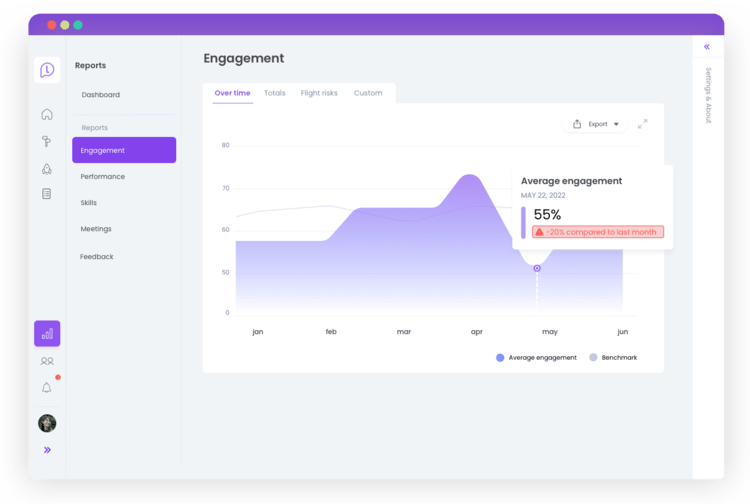In this blog, we cover four key challenges of remote performance management. We also discuss the solutions we have developed with our own customers. Would you rather get started right away with remote performance management for your organization? Then download the free e-guide: Design a modern interview cycle in 5 steps.
What is remote working?
Remote working, also known as telecommuting or working from home, refers to the practice of employees performing work outside the traditional office environment. This can be at home, in a café, a co-working space or any other location that is not the usual workplace. With advances in technology, such as high-speed Internet connections, cloud computing, and communication tools like video conferencing and chat applications, remote working is more accessible and efficient than ever before. For HR staff and managers, this form of work presents unique opportunities and challenges in recruitment, human resource management, and corporate culture retention.
Corona’s effect on remote working
Before the Corona crisis began, many companies were already replacing their traditional performance management cycle with continuous dialogue. As a result of mandatory remote working, this trend has accelerated. By 2020, digital support for HR processes has risen from place 7 to place 4 on the list of most important topics for HR professionals in the Netherlands. Consulting firm Berenschot surveyed that as many as 82% of HR professionals said they expect major changes in their organizations due to technological developments because of this crisis.
One of the main reasons why companies are accelerating investment in remote performance management is that before the corona crisis, many managers adopted a leadership style of “management by walking around.” This often involved managers literally on the shop floor in the office. This gave managers the ability to manage ad hoc for performance and behavior. In the remote situation, managers are asked to manage their employees remotely. As a result, obvious ways of working must suddenly be revised.
Benefits of working remotely
For employees:
-
- Improved work-life balance: It makes it easier for employees to pick up children from school or attend medical appointments without taking precious leave days.
- Reduced stress and travel time: By integrating remote working within your organization, you eliminate daily travel to and from work, saving employees valuable time and stress.
- Increased autonomy and control: This allows employees to customize their work environment according to their personal preferences, such as background music, temperature and ergonomics of their workspace.
- Improved health and well-being: Working remotely can also improve well-being. For example, they have more flexibility to prepare and consume healthy meals, exercise regularly and take adequate rest between work tasks.
For employers
-
- Increased productivity: Research by the CfPB, TU Delft and Eindhoven called “We Work at Home” shows that home workers rate their productivity an average of 7.7. While office workers rate their productivity at 6.7.
- Larger talent pool: By not relying on a fixed location, employers can recruit talent from a global talent pool. This significantly increases the chances of finding the perfect candidate.
- Cost savings: When your employees work largely remotely, you can save a lot of money on expensive and large office spaces.
- Sick leave is lower: The barrier to coming to the office causes people to call in sick faster. If the option of working from home is also there, people are more likely to choose to work from home when they are not feeling so well.
Disadvantages of working remotely
For employees:
-
- Isolation: The lack of personal contact with colleagues can lead to feelings of isolation and loneliness. This can have a negative effect on the mental health of your employees and eventually even lead to absenteeism.
- Work-life balance: It can be difficult to keep work and home separate as there is no clear beginning and end. This can make you more likely to work late into the evening, and this increases the risk of burnout.
- Self-discipline: Without the structure of an office environment, it can be challenging for some employees to stay motivated and productive.
- No promotion: Because employers are less likely to see the performance of employees who work from home, employees who work a lot from home are less likely to be promoted.
For employers
-
- Challenges in communication and collaboration: Without seeing each other physically on a regular basis, it can be more difficult to ensure effective communication and collaboration among members.
- Maintaining company culture: It can be challenging to maintain a strong company culture when employees do not see each other often.
- Security risks: Remote working can lead to increased security risks, especially if employees access company data over unsecured networks.
- Monitoring engagement and performance: With the elimination of social interaction, it becomes even more difficult to track how engaged your employees are and how they are performing.

With Learned, you implement continuous short MTOs with a few questions per week in the same time as an annual Employee happiness survey. This way you keep real-time insight into your employee engagement throughout the year and see the effect of your HR initiatives immediately. Try Learned now for 14 days for free!
Explanatory image: In this example, you can see the power of ongoing short Employee happiness surveys. Due to a negative situation in April, you see a sharp drop in employee engagement in May. Frequent measurements allow you to take immediate action on this.
Tips for making remote working a success
Tip 1: Invest in technology
Ensure that all team members have access to the necessary tools and technologies, such as video call software, collaboration platforms and secure VPN connections.
Tip 2: Promote communication
Encourage regular communication by setting set times for team meetings and using chat applications for daily interaction.
Tip 3: Set clear expectations
Make sure employees know what is expected of them in terms of working hours, tasks and results.
Tip 4: Support flexibility
Recognize that employees may need flexible working hours, especially when dealing with time zones or personal responsibilities.
Tip 5: Cultivate a strong company culture
Organize (virtual) team building activities and create an inclusive culture where everyone feels valued, regardless of their location.
Tip #6: Offer a budget for home offices
Recognize the importance of a comfortable and ergonomic home office for employee health and productivity. Consider offering a budget or allowance to purchase quality office chairs, desks, and other essential office supplies. This not only shows that you take your employees’ well-being seriously, but also helps prevent physical complaints such as back pain. By investing in your employees’ home offices, you promote a healthier work environment. In addition, you underscore the importance you place on their comfort and productivity, even remotely.
Learned: modern performance management focused on remote working
In recent years, there have been many developments in performance management software. At Learned, we have developed a platform that helps companies implement a modern performance management cycle. With tools for Goals (OKRs), we help managers agree clear goals with their team members and manage for output. In addition, we provide tools for 1:1 conversations and feedback. Thus, we help managers stay in ongoing conversation with their employees and monitor their engagement. By facilitating managers in adapting their management style and steering by output, we see that companies succeed in increasing their employee engagement and performance.
Are you curious to learn more about a modern interview cycle with “goals (OKRs),” a “continuous dialogue,” and fostering a “feedback culture”? Download the free Eguide: Design a Modern Conversation Cycle in 5 Steps. In it, we discuss practical tips on how you can create a modern performance and interview cycle that responds optimally to remote working.


























